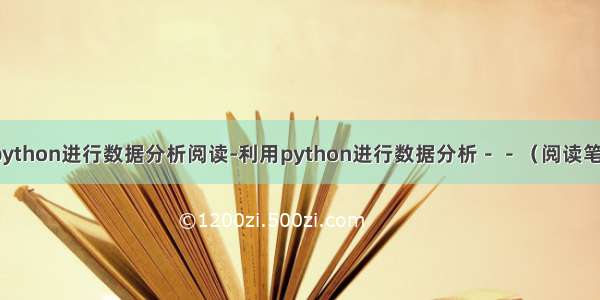
零售商品数据分析
文章目录
零售商品数据分析1、数据集描述2、明确分析目的3、理解数据4、数据清洗4、1 缺失数据4、1、1 统计缺失率4、1、2 删除缺失值4、2 转换数据类型4、3 重复值处理4、4 处理日期型数据4、5 根据需要新建数列5、数据分析5、1 目标1:找出购买商品数量前十的国家5、2 目标2:找出交易额前十的国家5、3 目标3:公司在哪些月份的销售量比较好5、4 目标4:客单价是多少5、5 目标5:用户行为分析5、6 目标6:基于RFM模型,对用户进行分类5、6、1 再次进行数据清洗5、6、1、1 转换Customer ID的数据类型为str5、6、1、2 处理日期5、6、1、3 新建字段5、6、1、4 重复值处理5、6、1、5 异常值处理5、6、2 R、F、M5、6、2、1 R5、6、2、2 F5、6、2、3 M5、6、3 用户分级5、6、4 拼接R、F、M5、6、5 定义分级函数5、6、6 统计用户等级分布情况5、6、7 对结果可视化5、7 目标7:退货订单分析6、总结这篇文章尝试着对一份零售商品数据进行分析,主要手段为描述统计与利用FRM模型进行客户分类,期望通过此次分析能达到如下目的:
1、找出购买商品数量前十的国家2、找出交易额前十的国家3、公司在哪些月份的销售量比较好4、客单价是多少5、用户行为分析6、基于FRM模型,对用户进行分类7、退货订单分析
我会将文中使用到的数据和源代码放在Github上,以便用得到的小朋友们下载:点此访问Github
1、数据集描述
这儿使用到的数据集来自Kaggle,该数据集包含-及-两个工作簿,记录了在英国注册的某公司网上零售的交易信息。主要销售产品为礼品。字段如下:
2、明确分析目的
1、找出购买商品数量前十的国家2、找出交易额前十的国家3、公司在哪些月份的销售量比较好4、客单价是多少5、用户行为分析6、基于FRM模型,对用户进行分类7、退货订单分析3、理解数据
# 导入相关库import numpy as npimport pandas as pdimport matplotlib.pyplot as pltimport seaborn as snsimport plotly as pyimport plotly.graph_objects as goimport csvimport ospyplot = py.offline.plotos.getcwd()os.chdir("F:\DataSets\online_retail")文中只对表格中的第一个工作簿进行分析(即-数据集),第二个工作簿分析可类似进行# 数据读入online_data = pd.read_excel("online_retail_II.xlsx")# 查看数据情况online_data.shape
(525461, 8)
online_data.head()
online_data.info()online_data.columns
<class 'pandas.core.frame.DataFrame'>RangeIndex: 525461 entries, 0 to 525460Data columns (total 8 columns):Invoice 525461 non-null objectStockCode525461 non-null objectDescription 522533 non-null objectQuantity 525461 non-null int64InvoiceDate 525461 non-null datetime64[ns]Price525461 non-null float64Customer ID 417534 non-null float64Country 525461 non-null objectdtypes: datetime64[ns](1), float64(2), int64(1), object(4)memory usage: 32.1+ MBOut[3]:Index(['Invoice', 'StockCode', 'Description', 'Quantity', 'InvoiceDate','Price', 'Customer ID', 'Country'],dtype='object')
4、数据清洗
4、1 缺失数据
4、1、1 统计缺失率
# 统计缺失率online_data.apply(lambda x: sum(x.isnull()) / len(x), axis=0)
Invoice 0.000000StockCode0.000000Description 0.005572Quantity 0.000000InvoiceDate 0.000000Price0.000000Customer ID 0.205395Country 0.000000dtype: float64
Description 0.005572 Description存在数据缺失的情况,缺失率约为0.56%,暂时无法进行填充Customer ID 0.205395 Customer ID存在数据缺失,缺失率20.5%
4、1、2 删除缺失值
# 删除缺失值df1 = online_data.dropna(how="any").copy()df1.info()
<class 'pandas.core.frame.DataFrame'>Int64Index: 417534 entries, 0 to 525460Data columns (total 8 columns):Invoice 417534 non-null objectStockCode417534 non-null objectDescription 417534 non-null objectQuantity 417534 non-null int64InvoiceDate 417534 non-null datetime64[ns]Price417534 non-null float64Customer ID 417534 non-null float64Country 417534 non-null objectdtypes: datetime64[ns](1), float64(2), int64(1), object(4)memory usage: 28.7+ MB
4、2 转换数据类型
# 转换数据类型# 转换Customer ID的数据类型为strdf1["Customer ID"] = df1["Customer ID"].astype(str)df1.info()
<das.core.frame.DataFrame'>Int64Index: 417534 entries, 0 to 525460Data columns (total 8 columns):Invoice 417534 non-null objectStockCode417534 non-null objectDescription 417534 non-null objectQuantity 417534 non-null int64InvoiceDate 417534 non-null datetime64[ns]Price417534 non-null float64Country 417534 non-null objectCustomer ID 417534 non-null objectdtypes: datetime64[ns](1), float64(1), int64(1), object(5)memory usage: 28.7+ MB
4、3 重复值处理
df1 = df1.drop_duplicates()
4、4 处理日期型数据
# 获取InvoiceDate日期部分df1["InvoiceDate"] = df1["InvoiceDate"].dt.date
4、5 根据需要新建数列
# 新建一个销售总金额的字段 销售金额 = 单价 * 数量df1["T_Price"] = df1.apply(lambda x: x[3] * x[5], axis=1)
5、数据分析
5、1 目标1:找出购买商品数量前十的国家
# 目标1:找出购买商品数量前十的国家df1[df1["Quantity"] > 0].groupby("Country")["Quantity"].sum().sort_values(ascending=False).head(10)
CountryUnited Kingdom 4430926Denmark 229690Netherlands 183679EIRE181413France 162048Germany 108633Sweden 52417Spain22841Switzerland 22255Australia 9Name: Quantity, dtype: int64
# 将结果可视化quan_top_10 = df1[df1["Quantity"] > 0].groupby("Country")["Quantity"].sum().sort_values(ascending=False).head(10)trace_0 = go.Bar(x=quan_top_10.index.tolist(),y=quan_top_10.values.tolist(),opacity=0.4)layout = go.Layout(title="商品交易量前十的国家", xaxis=dict(title="国家"))fig = go.Figure(data=trace_0, layout=layout)fig.show()
可进行交互选择查看:
5、2 目标2:找出交易额前十的国家
# 目标2:找出交易额前十的国家df1[df1["T_Price"] > 0].groupby("Country")["T_Price"].sum().sort_values(ascending=False).head(10)
CountryUnited Kingdom 7.381644e+06EIRE 3.560419e+05Netherlands 2.687844e+05Germany 2.020254e+05France 1.461071e+05Sweden 5.314799e+04Denmark 5.090685e+04Spain 4.756865e+04Switzerland 4.392139e+04Australia 3.144680e+04Name: T_Price, dtype: float64
# 将结果可视化p_top_10 = df1[df1["T_Price"] > 0].groupby("Country")["T_Price"].sum().sort_values(ascending=False).head(10)trace_0 = go.Bar(x=p_top_10.index.tolist(),y=p_top_10.values.tolist(),opacity=0.4)layout = go.Layout(title="商品交易额前十的国家", xaxis=dict(title="国家"))fig = go.Figure(data=trace_0, layout=layout)fig.show()
同样可进行交互选择查看
5、3 目标3:公司在哪些月份的销售量比较好
# 目标3:公司在哪些月份的销售量比较好df1["year"] = pd.to_datetime(df1["InvoiceDate"]).dt.yeardf1.sample(10)
# 本次数据含有、两年的销售情况# 对这两年分别进行统计df_09 = df1.where(df1["year"] == ).dropna(how="all").copy()df_09.shape
(31276, 10)
df_09.sample(10)
df_10 = df1.where(df1["year"] == ).dropna(how="all").copy()df_10.shape
(379487, 10)
09年数据量较少,仅45000行,数据有477533
df_09["month"] = pd.to_datetime(df1["InvoiceDate"]).dt.monthdf_09[df_09["Quantity"] > 0].groupby("month")["Quantity"].sum().sort_values(ascending=False)
month12 398708.0Name: Quantity, dtype: float64
我们可以得知,09年仅有12月的交易信息,无法得知其他月份信息,故无法进行比较
df_10["month"] = pd.to_datetime(df1["InvoiceDate"]).dt.monthdf_10[df_10["Quantity"] > 0].groupby("month")["Quantity"].sum().sort_values(ascending=False)
month11 653074.010 596497.09567806.03502101.08452551.06389880.05384960.02371871.01370128.04350604.07324638.012 157630.0Name: Quantity, dtype: float64
df1["InvoiceDate"].sort_values().head(5)
df_09["InvoiceDate"].sort_values(ascending=False).head(2)
09年数据自12-09 到12-23
df_10["InvoiceDate"].sort_values().head(2)
df_10["InvoiceDate"].sort_values(ascending=False).head(2)
数据自 01-04 到 12-09
观察各月份产品交易数量,发现12月份统计数量明显偏低,分析原因可能是因为12月信息统计不充分,考虑将09年12月数据填充至
df1["month"] = pd.to_datetime(df1["InvoiceDate"]).dt.monthdf1[df1["Quantity"] > 0].groupby("month")["Quantity"].sum().sort_values(ascending=False)
month11 65307410 596497956780612 55633835021018452551638988053849602371871137012843506047324638Name: Quantity, dtype: int64
绘制图形
# 绘制图形x1 = df1[df1["Quantity"] > 0].groupby("month")["Quantity"].sum().sort_values(ascending=False)trace_0 = go.Bar(x=x1.index.tolist(),y=x1.values.tolist(),marker=dict(opacity=0.8))layout = go.Layout(title="各月份商品交易数量", xaxis=dict(title="月份"))fig = go.Figure(data=trace_0, layout=layout)fig.show()
x2 = df1[df1["T_Price"] > 0].groupby("month")["T_Price"].sum().sort_values(ascending=False)trace_0 = go.Bar(x=x2.index.tolist(), y=x2.values.tolist(),marker=dict(opacity=0.8))layout = go.Layout(title="各月份商品交易额", xaxis=dict(title="月份"))fig = go.Figure(data=trace_0, layout=layout)fig.show()
可以得到,交易额与交易数量两个角度均表明销售最佳的月份是11月,其次是12月,下半年优于上半年。
原因分析:可能是因为数据来自欧美,他们的重大节日在下半年较多,促销活动也较多
5、4 目标4:客单价是多少
# 目标4:客单价是多少# 客单价 = 成交金额 / 成交用户数sum_price = df1[df1["Quantity"] > 0]["T_Price"].sum()count_no = df1[df1["Quantity"] > 0].groupby(df1["Customer_ID"]).count().shape[0]avgPrice = sum_price / count_noprint(avgPrice)
2039.4607658785349
计算得出,平均客单价为2039元
5、5 目标5:用户行为分析
# 目标5:用户行为分析# 从用户消费次数,用户消费金额,用户购买产品数量三个维度进行探讨customer_c = df1[df1["Quantity"] > 0].groupby("Customer ID").agg({"Invoice":"nunique","Quantity":np.sum,"T_Price":np.sum})customer_c.describe()
通过上诉统计信息我们可以得到:
近一年的时间里,客户平均消费频次为4次,消费次数最高的达到205次,大部分客户的消费频次都在5次以内近一年的时间里,客户平均消费金额为2039,中位数为700元,消费金额最高的客户达到349164.35元,是我们需要重点关注的对象从商品购买数量上看,大部分客户购买数量都在1000件以内
5、6 目标6:基于RFM模型,对用户进行分类
RFM模型简介:
RFM模型是衡量客户价值和客户创利能力的重要工具和手段。在众多的客户关系管理(CRM)的分析模式中,RFM模型是被广泛提到的。RFM是Rencency(最近一次消费),Frequency(消费频率)、Monetary(消费金额),三个指标首字母组合。我们利用这3项指标来描述该客户的价值状况。
对比分析不同用户群体在时间、地区等维度下的交易量、交易金额,根据分析结果提出优化建议。
这儿提供一组分组客户分组及其对应的营销策略及指标
# 目标6:基于RFM模型,对用户进行分类# 前期我们对Customer ID存在的缺失数据进行了删除(缺失率20.5%)# 我们对缺失的客户ID进行常值填充(也可类似之前做删除处理,看个人选择)online_data.info()
online_data.apply(lambda x: sum(x.isnull()) / len(x), axis=0)
# 同上,删除Description缺失数据df2 = online_data.dropna(subset=["Description"]).copy()# Customer ID的缺失数据通过U填充(U:表示未知)df2["Customer ID"] = df2["Customer ID"].fillna("U")
5、6、1 再次进行数据清洗
5、6、1、1 转换Customer ID的数据类型为str
# 转换Customer ID的数据类型为strdf2["Customer ID"] = df2["Customer ID"].astype(str)df2.info()
5、6、1、2 处理日期
# 获取InvoiceDate日期部分df2["InvoiceDate"] = df2["InvoiceDate"].dt.date
# 新建年,月,日三个特征# 获取InvoiceDate年份df2["year"] = pd.to_datetime(df2["InvoiceDate"]).dt.year# 获取InvoiceDate月份df2["month"] = pd.to_datetime(df2["InvoiceDate"]).dt.month# 获取InvoiceDate 日df2["day"] = pd.to_datetime(df2["InvoiceDate"]).dt.day
# 日期df2["date"] = pd.to_datetime(df2["InvoiceDate"])df2.drop(["InvoiceDate"], axis=1, inplace=True)df2.info()
df2.sample(5)
5、6、1、3 新建字段
# 新建一个销售总金额的字段 销售金额 = 单价 * 数量df2["T_Price"] = df2["Quantity"] * df2["Price"]
df2["T_Price"][:5]
5、6、1、4 重复值处理
# 重复值处理df2 = df2.drop_duplicates()
5、6、1、5 异常值处理
# 异常值处理df2.describe()
# 商品数量、单价存在负值或0# 商品数量df2_1 = df2.loc[df2["Quantity"] <= 0]df2_1.info()
print("异常值占比:", df2_1.shape[0] / df2.shape[0])
异常值占比: 0.02031349688849587
可能是退货
# 单价df2_2 = df2.loc[df2["Price"] <= 0]print("异常值占比:", df2_2.shape[0] / df2.shape[0])
异常值占比: 0.0014660624007353583
异常值占比: 0.0014660624007353583
df2_2["Price"].sample(2)
350849 0.0
516202 0.0
Name: Price, dtype: float64
df2_2["Price"].groupby(df2_2["Price"]).count()
Price-53594.361-44031.791-38925.8710.00 753Name: Price, dtype: int64
单价为0的记录有759条,可能此类货品为赠品;为负的三条记录其Description均为Adjust bad debt
# 剔除退货相关的数据df3 = df2.loc[(df2["Quantity"] > 0) & (df2["Price"] > 0)]
5、6、2 R、F、M
构建RFM值,并查看RFM信息,设置阈值
5、6、2、1 R
# R# 客户最近一次消费时间R_value = df3.groupby("Customer ID")["date"].max()# 计算出客户最后一次消费距离某个截至日期的天数(以所有客户中最近一次消费时间为基准)R = (df3["date"].max() - R_value).dt.days
R.describe()
# 绘图sns.set(style="darkgrid")sns.distplot(R, bins=25)
5、6、2、2 F
# 客户消费频率F = df3.groupby("Customer ID")["Invoice"].nunique()
F.describe()
# 绘图# 受客户ID未知U影响,我们只查看F<50的部分sns.distplot(F[F < 50], bins=25)
5、6、2、3 M
# 客户的消费金额M = df3.groupby("Customer ID")["T_Price"].sum()
M
df3.info()
# 同上受客户ID未知U影响,我们只查看M<10*(75% : 1.723450e+03)的部分plt.hist(M[M < 1.723e+04], color="c", alpha=.8)plt.show()
# 查看金额在75%内的分布:plt.hist(M[M < 1.73e+03], bins=100, color="c", alpha=.8)plt.show()
可见,客户ID缺失值用U填充对RFM值影响较大,接下来考虑删除缺失值,重复上述过程
# 剔除未知客户进行分析df4 = df3[~(df3["Customer ID"] == "U")]R1_value = df4.groupby("Customer ID")["date"].max()R1 = (df4["date"].max() - R1_value).dt.daysF1 = df4.groupby("Customer ID")["Invoice"].nunique()M1 = df4.groupby("Customer ID")["T_Price"].sum()
R1.describe()
plt.hist(R1, bins=25, color="c", alpha=.5)plt.show()
从图形上看,去掉U效果好了很多
F1.describe()
plt.hist(F1[F1 < 50], color="c", alpha=.5)plt.show()
M1.describe()
count4312.000000mean 2040.399825std 8911.756229min 2.95000025% 307.18750050% 701.61500075% 1712.512500max349164.350000Name: T_Price, dtype: float64
plt.hist(M1, color="c", alpha=.5)plt.show()
存在最大值349164干扰,导致图形展示效果较差,故调整展示范围
# 存在最大值349164plt.hist(M[M < 2000], bins=100, color="c", alpha=.5)plt.show()
5、6、3 用户分级
# 用户分级# binsR_bins = [0, 25, 50, 100, 200, 400]F_bins = [1, 2, 5, 10, 100, 300]M_bins = [0, 300, 600, 2000, 10000, 500000]# 离散化R_score = pd.cut(R1, R_bins, labels=[5, 4, 3, 2, 1], right=False)F_score = pd.cut(F1, F_bins, labels=[1, 2, 3, 4, 5], right=False)M_score = pd.cut(M1, M_bins, labels=[1, 2, 3, 4, 5], right=False)RFM = pd.concat([R_score, F_score, M_score], axis=1)RFM.rename(columns={"date": "R_score","Invoice": "F_score","T_Price": "M_score"},inplace=True)RFM.head()
转换数据类型
# 转换数据类型RFM.info()for i in ["R_score", "F_score", "M_score"]:RFM[i] = RFM[i].astype(float)RFM.describe()
设定平均值为阈值,数值大于平均值这标记为“高”,小于均值标记为“低”
# 设定平均值为阈值,数值大于平均值这标记为“高”,小于均值标记为“低”RFM["R"] = np.where(RFM["R_score"] > 3.337199, "高", "低")RFM["F"] = np.where(RFM["F_score"] > 2.039889, "高", "低")RFM["M"] = np.where(RFM["M_score"] > 2.554267, "高", "低")
RFM.sample(10)
5、6、4 拼接R、F、M
# 拼接R、F、MRFM["value"] = RFM["R"].str[:] + RFM["F"].str[:] + RFM["M"].str[:]
5、6、5 定义分级函数
# 定义分级函数def grade(x):if x == "高高高":return "重要价值客户"elif x == "低高高":return "重要保持客户"elif x == "高低高":return "重要发展客户"elif x == "低低高":return "重要挽留客户"elif x == "高高低":return "一般价值客户"elif x == "低高低":return "一般保持客户"elif x == "高低低":return "一般发展客户"else:return "一般挽留客户"
5、6、6 统计用户等级分布情况
RFM["grade"] = RFM["value"].apply(grade)RFM["grade"].value_counts()
一般挽留客户 1294
重要价值客户 917
重要挽留客户 661
一般发展客户 634
重要发展客户 543
重要保持客户 241
一般价值客户 13
一般保持客户 9
Name: grade, dtype: int64
5、6、7 对结果可视化
# 对结果可视化trace_1 = go.Bar(x=RFM["grade"].value_counts().index.tolist(),y=RFM["grade"].value_counts().values.tolist(),opacity=.5)layout = go.Layout(title="用户等级信息", xaxis=dict(title="用户等级标签"))fig = go.Figure(data=trace_1, layout=layout)fig.show()
trace_2 = go.Pie(labels=RFM["grade"].value_counts().index.tolist(),values=RFM["grade"].value_counts().values,hole=0.35,textfont=dict(size=12, color="white"))layout = go.Layout(title="用户等级比例")fig = go.Figure(data=trace_2, layout=layout)fig.show()
5、7 目标7:退货订单分析
# 7、退货订单分析# 退货金额合计r = pd.pivot_table(df2_1,index=["year"],columns=["month"],values=["T_Price"],aggfunc={"T_Price": np.sum},margins=False)r.fillna(0)
# 计算退货率: 退货率 = 退货合计金额 / 总金额# 总金额 (df3:剔除退货后的数据)t = pd.pivot_table(df3,index=["year"],columns=["month"],values=["T_Price"],aggfunc={"T_Price": np.sum},margins=False)t.fillna(0)
# 退货率r_rate = round(-r / t * 100, 5)r_rate = r_rate.fillna(0)r_rate.reset_index(drop=True,inplace=True)
r_rate# r_rate.loc[1][:].tolist()r_rate.loc[0].index.levels[1]
# 对结果可视化trace_1 = go.Bar(x=r_rate.loc[0].index.levels[1].tolist(),y=r_rate.loc[0].tolist(),opacity=.5,name="")trace_2 = go.Bar(x=r_rate.loc[0].index.levels[1].tolist(),y=r_rate.loc[1][:].tolist(),opacity=.5,name="")layout = go.Layout(title="退货信息",xaxis=dict(title="月份"),yaxis=dict(title="退货率(百分比)"))fig = go.Figure(data=[trace_1, trace_2], layout=layout)fig.show()
6、总结
交易量前十的国家及其交易量分别为:交易额前十的国家及其交易金额分别为:从交易额与交易数量两个角度均表明该公司销售最佳的月份是11月,其次是12月,下半年优于上半年。原因分析:可能是因为数据来自欧美,他们的重大节日在下半年较多,促销活动也较多在-12到-12期间:平均客单价为2039元近一年的时间里,客户平均消费频次为4次,消费次数最高的达到205次,大部分客户的消费频次都在5次以内这一年的时间里,客户平均消费金额为2039,中位数为700元,消费金额最高的客户达到349164.35元,是我们需要重点关注的对象从商品购买数量上看,大部分客户购买数量都在1000件以内通过RFM模型,我们将用户分为了8各类别。该公司用户数量最多的为一般挽留客户与重要价值客户,占总用户数的51.3%,其次为重要挽留客户与一般发展客户,共占总用户数的30%。公司可以参考此用户等级及其所占占比策划营销活动,有助于提升活动效果及营销费用的利用率从退货情况来看,12月退货率明显偏高,可参考该月份及上月销售情况及内外部因素综合考虑,分析退货率高的原因。(提供几个思考方向:产品本身,销售渠道,价格,是否是促销,售后等方面)
以上便是我对这份零售数据进行的一次探索分析,相信其中会有很多不足之处,欢迎有缘读到此篇文章的小朋友们批评指正,如有能启发或帮助到你的地方,我将倍感荣幸。(●’◡’●)














